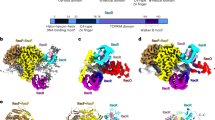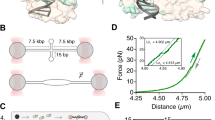Summary
From Escherichia coli cells we purified ‘8’-shaped dimeric molecules in which two circular DNA molecules of bacteriophage lambda were joined at a homologous site. Some of them had a complex junction which we interpreted as being two closely spaced Holliday structures because of (i) superhelicity of the molecule, (ii) the sedimentation rate of the molecule in sucrose gradients, and (iii) the appearance in the electron microscope. Other ‘figure-eights's’ had two separate homologous junctions, presumably two Holliday bridges. A possible role for these ‘double Holliday structures’ in UV-stimulated recA-dependent recombination in vivo is discussed.
Similar content being viewed by others
References
Benbow, RM, Zuccarelli AJ, Sinsheimer RL (1975) Recombinant DNA molecules of bacteriophage ϕX174. Proc Natl Acad Sci USA 72:235–239
Boon T, Zinder ND (1971) Genotypes produced by individual recombination events involving bacteriophage fl. J Mol Biol 58:133–151
Broker T, Lehman R (1971) Branched DNA molecules: Intermediates in T4 recombination. J Mol Biol 60:131–149
Champoux J (1977) Renaturation of complementary single-stranded DNA circles: Complete rewinding facilitated by the DNA untwisting enzyme. Proc Natl Acad Sci USA 74:5328–5332
Cross RA, Lieb M (1967) Heat inducible λ prophage. V. Induction of prophages with mutations in genes O, P, and R. Genetics 57:549–560
Cunningham, RP, DasGupta C, Shibata T, Radding CM (1980) Homologous pairing in genetic recombination: recA protein makes joint molecules of gapped circular DNA and closed circular DNA. Cell 20:223–235
DasGupta C, Wu AM, Kahn R, Cunningham RP, Radding CM (1981) Concerted strand exchange and formation of Holliday structures by E. coli recA protein. Cell 25:507–516
Holliday R (1964) A mechanism for gene conversion in fungi. Genet Res 5:282–304
Ikeda H, Kobayashi I (1977) Involvement of DNA-dependent RNA polymerase in a recA − independent pathway of genetic recombination in Escherichia coli. Proc Natl Acad Sci USA 74:3932–3936
Ikeda H, Kobayashi I (1979) recA-mediated recombination of bacteriophage λ: Structure of recombinant and intermediate DNA molecules and their packaging in vitro. Cold Spring Harbor Symp Quant Biol 43:1009–1021
Ikeda H, Matsumoto T (1979) Transcription promotes recA-independent recombination mediated by DNA-dependent RNA polymerase in Escherichia coli. Proc Natl Acad Sci USA 76:4571–4575
Kobayashi I, Ikeda H (1977) Formation of recombinant DNA of bacteriophage lambda by recA function of Escherichia coli without duplication, transcription, translation, and maturation. Mol Gen Genet 153:237–245
Kobayashi I, Ikeda H (1978) On the role of recA gene product in genetic recombination: An analysis by in vitro packaging of recombinant DNA molecules formed in the absence of protein synthesis. Mol Gen Genet 166:25–29
Murray NE, Murray K (1974) Manipulation of restriction targets in phage λ to form receptor chromosomes for DNA fragments. Nature 251:476–481
Potter H, Dressler D (1976) On the mechanism of genetic recombination: Electron microscopic observation of recombination intermediates. Proc Natl Acad Sci USA 73:3000–3004
Potter H, Dressler D (1978) In vitro system from Escherichia coli that catalyzes generalized genetic recombination. Proc Natl Acad Sci USA 75:3698–3702
Sobell HM (1972) A mechanism to activate branch migration between homologous DNA molecules in genetic recombination. Proc Natl Acad Sci USA 69:2483–2487
Thompson BJ, Escarmis C, Parker B, Slater WC, Doniger J, Tessman I, Warner RC (1975) Figure-8 configuration of dimers of S13 and ϕX174 replicative form DNA. J Mol Biol 91:409–420
Valenzuela MS, Inman RB (1975) Visualization of a novel junction in bacteriophage λ DNA. Proc Natl Acad Sci USA 72:3024–3028
West SC, Cassuto E, Howard-Flanders P (1981) Mechanism of E. coli recA protein directed strand exchanges in post-replication repair of DNA. Nature 294:659–662
Whitehouse HLK (1963) A theory of crossing-over by means of hybrid deoxyribonucleic acid. Nature 199:1034–1040
Author information
Authors and Affiliations
Additional information
Communicated by W. Arber
Rights and permissions
About this article
Cite this article
Kobayashi, I., Ikeda, H. Double holliday structure: A possible in vivo intermediate form of general recombination in Escherichia coli . Mol Gen Genet 191, 213–220 (1983). https://doi.org/10.1007/BF00334816
Received:
Issue Date:
DOI: https://doi.org/10.1007/BF00334816




